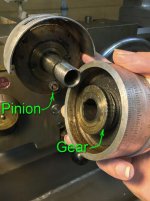Mikel Levy
Aluminum
- Joined
- Oct 19, 2009
- Location
- Seattle
I took off the crank handle/micrometer dial assembly from the cross slide of my recently acquired Chippie because of a slight rubbing issue at one rotational position of the handle. What do I find but a very fine-toothed gear solidly mounted and affixed to the inside of the handle, driving a small pinion (as the handle is rotated), mounted on the proximal end of the leadscrew bearing bracket (please see attached photo). The pinion is not attached to any other component, so as far as I can tell, when driven by the gear it just spins on its little bronze stud, to no effect (other than producing the "rubbing" issue because of a slight wobble in the crank handle).
I have downloaded three different versions of the user manual for this lathe, and this gear and pinion are not documented in any of them (nor are the dual imperial/metric micrometer dials mentioned).
Anyway, I'm prone to missing the obvious, and maybe I can't see the forest for the trees, but can anyone tell me what the purpose of this gear and pinion is?
--Mike

I have downloaded three different versions of the user manual for this lathe, and this gear and pinion are not documented in any of them (nor are the dual imperial/metric micrometer dials mentioned).
Anyway, I'm prone to missing the obvious, and maybe I can't see the forest for the trees, but can anyone tell me what the purpose of this gear and pinion is?
--Mike



